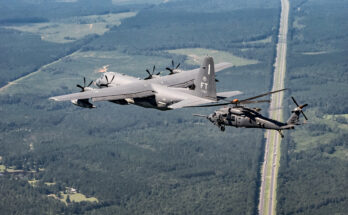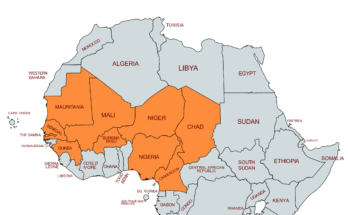
Every afternoon, a Mexican Army platoon lowers the monumental flag in Constitution Square, or Zócalo. Image – ProtoplasmaKid / Wikimedia
When, in the wake of a shocking string of criminal massacres, Mexican President Felipe Calderon first deployed the Mexican armed forces to combat organized crime on the country’s streets in 2006, few envisioned that the episode would constitute only the opening salvo of an internal war that has since stretched over 15 years without an end in sight. What first began as an ad-hoc and provisional response to urgent requirements steadily laid the foundations for the permanent expansion and transformation of both the functional purview and institutional authority of the Mexican armed forces. Mexican executives, facing pervasive street violence and frustrated by the inadequacy and unreliability of regional law enforcement structures, progressively reoriented the central mission of the Mexican armed forces from one of territorial defense and deterrence to one of internal policing.
Although successive Mexican governments continued to maintain that the collapse of major cartel networks or the institution of security sector reforms would one day allow for the demilitarization of the national law enforcement strategy, a string of political developments over 2022 could presage the definitive end to this aspiration. Under proposals submitted over the past two years by the incumbent executive administration of Andres Manuel Lopez Obrador, the force structure of the Mexican military could be on the cusp of a profound reconfiguration that would shape the outlook of Mexican national security strategy and the state of civil-military relations for years to come. The Obrador administration has abandoned its once ambitious plans to restore the jurisdiction over internal security to a civilian body and instead enacted nascent security sector reforms aimed at formalizing the tacit reality that the armed forces are liable to remain the preeminent actor within Mexico’s internal security apparatus for the foreseeable future. Although judicial opposition to several of the administration’s most consequential reform proposals is liable to complicate their path toward realization, the Obrador administration’s political journey from arch-skeptic to committed proponent of deepening security sector militarization neatly encapsulates the pressures and compromises imposed upon successive Mexican governments over the past 15 years of seemingly intractable violence.
Just a few short years ago, the situation appeared to be on a very different trajectory. Established by the Obrador administration with great fanfare in 2019, the Mexican National Guard was originally envisioned as a far more ambitious successor to the piecemeal attempts at creating new gendarmerie structures pursued under previous administrations. Formed via the consolidation of personnel from the military and Federal Police (Federales) and subject to a civilian minister under the newly established Secretariat of Security and Civilian Protection (SSPC), the Guard appeared to signal the beginning of the end to the prolonged era of militarized policing, with the administration promising that the Army’s “return to the barracks” was at last imminent. Ironically, however, the Guard could instead serve as the basis for one of the largest expansions of military authority in decades.
Despite the steady growth and maturation of the Guard’s manpower pool and operational capacity over the two years subsequent to its creation, by 2021 the Obrador administration had already begun floating proposals to subordinate the Guard to the Defense Secretariat (SEDENA) as a military service branch, a decision guided by both urgent practical necessities and the administration’s deepening relationship with the armed forces. The SEDENA oversees Mexico’s Army and Air Force service branches, with the autonomous Secretariat of the Navy (SEMAR) managing the country’s maritime security portfolio. With the intensifying political salience of Central American migration to Mexico’s bilateral relationship with the United States often rendering the still understaffed Guard preoccupied with enforcing border controls, and regional law enforcement bodies still unable to stem the persistence of near record homicide rates through 2022, the military once again appeared to stand as the sole state entity capable of systematically responding to the country’s security crisis on a national scale. The belief that the armed forces are the only body possessing the requisite discipline, strategic outlook, and material largess to reliably execute the government’s national security objectives serves as the foundational assumption guiding the Obrador administration’s incipient security reforms.

National Guard of Mexico. Image – Gobierno de México
In September 2022, the Obrador administration secured legislative approval for the subordination of the Guard to the SEDENA from the Mexican Senate in a contentious 71-51 vote. The realization of such a reform would see both the personnel and budgetary base of the SEDENA increased by orders of magnitude over the coming years. With the combined force strength of the Army and Navy currently standing at 178,000 personnel, the prospective incorporation of at least 110,000 National Guard troops would nearly double the number of active-duty personnel answering to the SEDENA. The impact of such a reform on the scope of the SEDENA’s financial responsibilities would be equally dramatic. Under the 2023 state budget, the SEDENA and SSPC were appropriated annual sums of MXN111.9 billion ($6.2 billion) and MXN100.0 billion ($5.58 billion), respectively. Although it is not yet clear precisely how the SSPC’s current budget would be redistributed in the event of a restructuring, it is not unfeasible that appropriations for the SEDENA could exceed MXN200.0 billion ($11.6 billion) annually if the Guard’s conversion into a military service branch is made permanent.
Even excluding the proposed incorporation of the Guard, the scope of the military’s influence in civil affairs has expanded tremendously over the past several years alone. Frustrated by the persistence of official corruption and seeking means to slash the Gordian knot of Mexico’s many internal governance deficits, the SEDENA has become ever more deeply enmeshed in previously civilian-led corners of Mexico’s society and economy. The administration has pinned considerable hopes on the uncertain prospect that the relative professionalism and discipline of the armed forces will prove capable of delivering results in domains where many civil institutions and law enforcement bodies have hitherto struggled to do so. From assuming control of many of the nation’s air and sea ports under the new National Customs Agency of Mexico (ANAM) to managing the implementation of flagship infrastructural development projects such as the Maya Train railway network, the military has assumed jurisdiction over a diverse range of posts and administrative functions that lie well outside of their conventional areas of specialization. In 2023, the Mexican government announced that the SEDENA would assume ownership of the defunct Mexicana commercial airline brand, with the revived carrier intended to provide the military with an additional source of external financing outside of annual budgetary channels.
Overseeing the widening operational responsibilities of the SEDENA is a centralized new general staff structure. The Obrador administration ratified the establishment of the Joint Chiefs of Staff of the Superior General Headquarters of the Mexican Army and Air Force by presidential decree in February 2022, putting an end to years of jurisdictional and hierarchical fragmentation between Mexico’s service branches. Whether it be the creation of the Joint Chiefs, the subordination of the Guard, or the placement of military personnel in civil posts, centralization is a guiding principle behind the government’s recent reform initiatives, informed by mutual distrust between the center and regional authorities and a determination that national policy and security strategy must be implemented and enforced from above if it is ever to be realized.
These centralizing forces, alongside lingering questions as to whether the military’s forward-facing reputation for efficacy and incorruptibility align with reality, form the basis of skepticism on the part of Mexican civil society, the judiciary, and the political opposition as to whether deepening militarization is a truly viable solution to Mexico’s problems. Under the preceding presidential administration of Enrique Pena Nieto, Mexican security forces worked tirelessly to achieve what many hoped were the first watershed blows against the country’s most powerful cartel networks, successfully arresting and extraditing infamous cartel ringleaders such as the Sinaloa Cartel’s Joaquín “El Chapo” Guzmán, who had long evaded justice through cunning and corruption. Yet, far from granting ordinary Mexicans a reprieve from violence, the resulting power vacuum and fragmentation of major cartel networks instead saw homicide rates surging toward new records by the time of the Obrador administration’s inauguration, with only marginal and often transient improvements materializing over the subsequent years.
As the military’s dominion over sectors once presided upon by long-troubled civil authorities continues to expand, the question also arises as to whether its personnel will instill a new atmosphere of discipline and reliability upon these institutions or simply become entangled and compromised in the same rent-seeking behaviors as their civilian predecessors. Indeed, the military’s own checkered history suggests that these concerns are not unwarranted, as from the very center of the Defense Secretariat down to individual soldiers on the streets, the military is no stranger to allegations of corruption and other extralegal behavior. In 2019, the United States unsuccessfully moved to indict former Defense Secretary and general Salvador Cienfuegos on the basis of allegedly having direct ties to a major cartel network in an incident that quickly turned into a diplomatic row between the two countries. On the ground floor, the possible involvement of military formations in a trail of extrajudicial killings has generated sustained but often unheard protests from both Mexican civil society groups and international human rights organizations regarding the lack of transparency and accountability governing the actions of the state’s most influential security institution.
Yet, any attempt to reverse the process of militarization poses its own practical and political risks to Mexican executives. Indeed, the Obrador administration’s own about-face on the issue did not emerge out of a vacuum but was in part driven by unanticipated blowback from its original strategy that was intended to do just that. Cognizant of the fact that the recent tactical victories against the cartels under Nieto had not yielded the intended outcomes in violence reduction, in the opening year of its tenure the Obrador administration attempted to implement a de-escalatory approach to managing the drug war colloquially referred to as “hugs not bullets.” However, criminal violence remained pervasive under this strategy too, and when the administration received vociferous criticism from both the press and security professionals for its response to a 2019 incident in which cartels brazenly attacked a government convoy that had been ferrying the son of El Chapo, the strategy of de-escalation was henceforth abandoned as a failed experiment. In the years since, the administration has proven highly sensitive, and responsive, to potential sentiments of discontent among the leadership of the armed forces, given its critical role in the country’s security landscape and the checkered history of civil-military relations in Latin America, often seeking to adapt its policies to their criticisms and reconcile their preferences with its own whenever possible.

President López Obrador during the 211th Anniversary of the Cry for Independence Celebration. Image – Gobierno de México
For the immediate term, the process of security sector consolidation and militarization has entered an interregnum on account of lingering questions of constitutionality. In April 2023, Mexico’s Supreme Court of Justice of the Nation vetoed the recently passaged legislation approving the subordination of the National Guard to the SEDENA on just such grounds. With Obrador soon scheduled to leave office and unable to run for re-election in 2024, and his MORENA Party currently lacking the seats necessary to pass a constitutional amendment, the ruling presents a significant setback for the administration’s security sector reform plans. However, with Obrador’s personal popularity ratings showing great resilience and a controversial package of election reforms likely to lend the MORENA Party a strong starting position in the coming election cycle, there is little prospect that these reform proposals will be rendered dormant for long.
No matter who emerges as the presidential successor to Obrador and what party gains standing in the legislature, future Mexican governments will face the same contradictory pressures and questions that have so bedeviled the current one. In nearby El Salvador, the process of militarization has reached its apotheosis under a totalizing strategy enacted by incumbent President Nayib Bukele that has attracted immense international controversy but an equally large number of acolytes across the American region. Although human rights criticisms of the strategy abound and many pointed questions about its genuine efficacy remain, the apparent decline in homicides in what was once one of the world’s most violence-wracked countries in the wake of Bukele’s suspension of civil liberties and imprisonment of tens of thousands of suspected gang members has catapulted his personal approval ratings to among the highest in Latin America. For exhausted leaders and populations across the region, the prospect that dramatic, muscular action could provide a pathway to normalcy from the shadow of decades of devastating violence has made the controversial president into a potential model to emulate.
Whether militarization is a prerequisite or impediment to the state’s ability implement the kind of long-term solutions necessary to address the economic, social, and political root causes of crime remains an unresolved question. Whatever the ultimate answer, however, the recent historical trajectory of these processes appears to trend nearly inexorably toward the further embrace of militarization, barring the marshalling of significant political will against it, presenting potential quandaries regarding both the status of the state in society and the balance of civil-military relations in the future. If investment in the military domain is not paired with efforts to improve the civil sector, regional governments risk falling into a cycle of underinvestment, underperformance, and subsequent reactive militarization that will continue to overextend the function of the armed forces well beyond its intended mission profile. As the Mexican and other militaries progressively assume more responsibilities once performed by civil institutions, the prospect for the progressive disintegration of overall state capacity becomes ever more pronounced. Although there are few indications that Latin America is lurching toward a return to an era of formal military rule, a future in which many democratically elected civilian executives stand atop a heavily militarized but otherwise emaciated state apparatus appears increasingly plausible in many states across the region.
A lifelong enthusiast of armored vehicles, Thomas serves as an analyst on Forecast International's Military Vehicles Forecast product. In addition, Thomas is responsible for updating the reports and analysis within Forecast International's International Military Markets – Latin America & Caribbean product. He also provides analysis for Forecast International's Airborne Retrofit & Modernization Forecast. Before this assignment, Thomas served as a research assistant for Forecast International's analytical team and has made written contributions to the Civil Aircraft Forecast, Military Aircraft Forecast, and Rotorcraft Forecast services. Thomas derives his knowledge from a multidisciplinary background, with a strong emphasis on the history and politics of Russia and the former satellite republics of the Soviet Union. He has studied in the Russian Federation at Saint Petersburg State University and is proficient in the Russian language at an advanced level.




